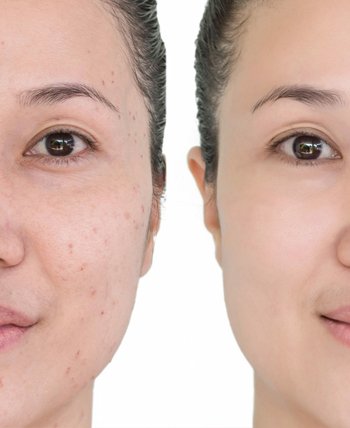Over 5,000 successful surgeries, Highly Experienced Surgeons, Comprehensive Skin & Hair care
Laser hair removal is a medical procedure that uses a concentrated beam of light (laser) to remove unwanted hair.

During laser hair removal, a laser emits a light that is absorbed by the pigment (melanin) in the hair. The light energy is converted to heat, which damages the tube-shaped sacs within the skin (hair follicles) that produce hairs. This damage inhibits or delays future hair growth.
Although laser hair removal effectively delays hair growth for long periods, it usually doesn't result in permanent hair removal. Multiple laser hair removal treatments are needed for initial hair removal, and maintenance treatments might be needed as well. Laser hair removal is most effective for people who have light skin and dark hair.
Laser hair removal is used to reduce unwanted hair. Common treatment locations include legs, armpits, upper lip, chin and the bikini line. However, it's possible to treat unwanted hair in nearly any area, except the eyelid or surrounding area.
Hair color and skin type influence the success of laser hair removal. The basic principle is that the pigment of the hair, but not the pigment of the skin, should absorb the light. The laser should damage only the hair follicle while avoiding damage to the skin. Therefore, a contrast between hair and skin color - dark hair and light skin - results in the best outcomes.
Acne scars are usually the result of inflamed blemishes caused by skin pores engorged with excess oil, dead skin cells and bacteria. The pore swells, causing a break in the follicle wall. Shallow lesions are usually minor and heal quickly. But if there is a deep break in the wall of the pore, infected material can spill out into surrounding tissue, creating deeper lesions. The skin attempts to repair these lesions by forming new collagen fibers. These repairs usually aren't as smooth and flawless as the original skin.

Physical, emotional and social reasons for treating acne scars include:
Pigmentation is a discoloration of skin due to excess generation of a pigment known as melanin.
Causes of skin pigmentation are inflammation, injury, hormones, genetics or use of excessive abrasive products on skin.

Some pigmentation are present since birth like nevi, while some can appear at a later age like melasma and freckles.
Most of the pigmentation are superficial that is at the epidermal level. However some spots like nevi and certain dermatological conditions are deep seated at the dermis level.
Usage of sunscreen as protective measure plays a vital role in the treatment of these pigmented spots.
Brightening serum and depigmenting creams help in reduction of these pigmentation as recommended by Dermatologists. Laser and chemical peel help in the faster recovery of these marks as they target deep seated pigments like melanin.
Stretch marks also known as Striae distensae is a very common Dermatological condition treated in skin clinics.
Here because of excessive stretching of skin that happens because of rapid gain or loss in weight results in disruption of collagen fibres in dermis and hence the appearance of broken skin picture.

Stretch marks are best prevented especially in pregnancy where proper oil massage during abdomen stretching will help in reduction of occurrence of stretch marks.
However once appeared, aggressive treatment with topical retinoids and alpha hydroxy acids in combination with Microneedling Radiofrequency(MnRf) will give good results in its reduction. MnRf uses microneedling technique of delivery of Radiofrequency waves into the dermis which causes remodeling of collagen fibers and hence better appearance of stretch marks. This procedure when clubbed with PRP, gives more effective results. Though stretch marks treatment needs multiple sittings, the results post procedure are satisfactory.
Tattoo removal is a procedure done to remove an unwanted tattoo. Common techniques used for tattoo removal include laser surgery, surgical removal and dermabrasion.
Tattoo ink is placed beneath the top layer of the skin. That makes tattoo removal more complicated - and expensive - than the original tattoo application.

If you're interested in tattoo removal, consult a skin doctor (dermatologist) about the options. Don't attempt tattoo removal on your own. Do-it-yourself tattoo removal creams and other home treatments aren't likely to be effective and can cause skin irritation or other reactions.
You might consider tattoo removal if you regret a tattoo or you're unhappy with the appearance of your tattoo. Perhaps the tattoo has faded or blurred, or you decide that the tattoo doesn't fit your current image.
Tattoo removal might also be important if you develop an allergic reaction to the tattoo or other complications, such as an infection.
If you're considering tattoo removal, consult a dermatologist. He or she can explain the options for tattoo removal and help you choose the method that's most likely to be effective for your tattoo.
For example, some tattoo inks are more responsive to laser treatment than are others. Likewise, small tattoos might be good candidates for surgical removal, while others are simply too large to remove with a scalpel.
Book an appointment and consult our dermatologists & plastic surgeons. Understand the problem and procedures in detail. We believe in giving sufficient time to our patients and help them make the right decision.